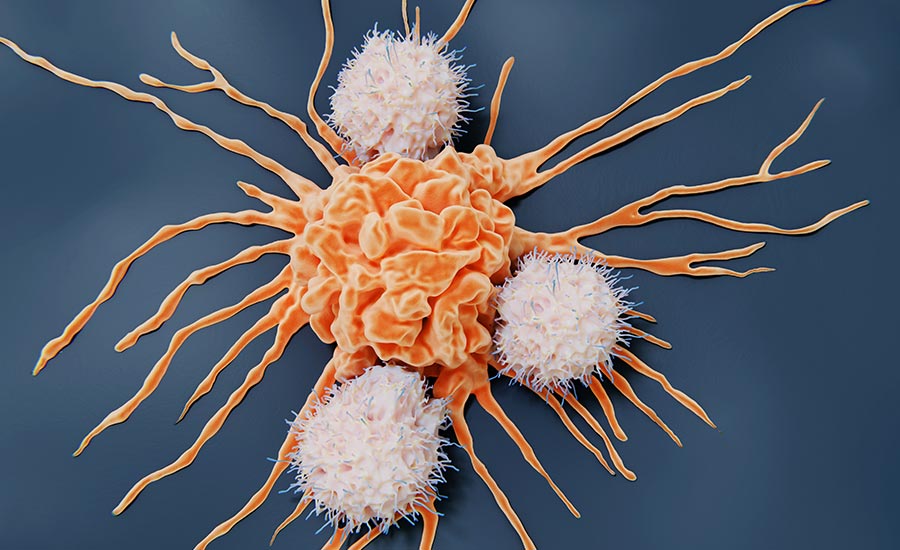Related Resources
Natural Killer Cells were first discovered in 1975 when a team of Swedish scientists noticed a new type of lymphocytes that didn’t belong to the B-Cell and T-Cell squadrons.
They also realized that these cells possess a natural cytotoxicity that allows them to kill tumors. That’s how these cells got their fearsome name — Natural Killer Cells!
We’ll discover how Natural Killer Cells function in your body and discuss all the ways they impact your well-being and why they truly are the elite warriors of your immune system!

What Are Natural Killer Cells?
Natural Killer Cells (NK cells) are a type of lymphocytes that can identify and fight viruses and cancerous cells.
Lymphocytes belong to leukocytes, i.e., white blood cells.
NKCs are called “natural” because, unlike other immune cells, these warriors don’t require prior training to recognize bad cells. Instead, they have an innate ability to kill invaders.
For example, cytotoxic T-Cells need to be activated through their antigen receptors (antigens are molecules on the pathogen’s surface). But NK cells don’t need that sort of stimulation. Instead, these guys are immediately ready for attack.
NK cells live in your blood and some of your organs, including your liver, spleen, bone marrow and lungs.
The moment they notice cells that don’t belong in your body and are potentially harmful to your health, they initiate an attack on the enemies.
NK cells are like your body’s emergency team, ready to fight off tumors and virus-infected cells.
They’re always on the move, scanning your body for stressed or damaged cells, even without the usual signals like antibodies. This quick reaction makes them a super important part of your immune system’s first line of defense!
In the BIOWARS universe, NK cells are personified as the brave Syrinx and Cytox. These two are among the most feared warriors within the BIOVERSE, both by enemies and fellow protectors of the immune system.
And why is that you might ask?
Well, let’s just say that NK cells are willing to do whatever it takes to destroy infected cells, even if that means killing the allies that got infected along the way.
We’ll explain more about this soon!

What Types Of Natural Killer Cells Exist?
There are two main types of NK cells:
- CD56bright: These cells make up around 40-60% of all NK cells in your blood. CD56bright cells are believed to be involved in the early stages of your body’s immune response, alongside macrophages and neutrophils (also types of white blood cells). They release cytokines, which tell other cells in the body to come and help fight off the bad guys. But more on this soon!
- CD56dim: These guys make up the majority of all NK cells. They are the “adaptive” kind because they spur into action in the later stages of the immune response. CD56dim cells are the killers — they produce cytotoxins and get rid of the cells infected with viruses as well as cancer cells.
Now, based on their function, NK cells can be further grouped into two more subsets:
- Cytotoxic NK cells
- Regulatory NK cells
It’s important to mention that cytotoxic and regulatory NK cells are not mutually exclusive. This means that one NK cell can have both cytotoxic and regulatory qualities.













































1. Cytotoxic NK Cells
Cytotoxic NK cells, a.k.a., effector NK cells have the ability to release cytotoxins — substances used as weapons that these cells (and cytotoxic T-Cells, too!) use to destroy the cells that wish to harm you.
When cells are healthy, they have the so-called MHC class I molecules on their surface. These proteins are like ID cards within the world of cells; they contain information on the role of each cell in your body.
When a cell is infected or cancerous, its MHC I protein is different than that on the surface of the healthy cells.
As soon as the effector NK cells detect the malicious cells with their receptors, they initiate the cytotoxic attack.
Cytotoxins are so powerful that they create holes in the membrane of the targeted cells. Then they infiltrate the said cells, triggering them to either break apart or undergo cell death, called apoptosis!
Although this process may sound scary, it’s actually cool and comforting to know how powerful our bodies are and what they do to fight off invaders!
Sometimes, the bad guys can be sneaky and hide their MHC I proteins, so they can go undetected; if that happens, then the NK cells won’t initiate the immune response against the imposters.
2. Regulatory NK Cells
Regulatory or inhibitory NK cells release cytokines — molecules that regulate the immune response.
This subset of NK cells can’t kill infected cells.
However, by preventing the immune system from overreacting to inflammation, regulatory NK cells also prevent autoimmunity.
Now let’s discuss the way natural killer cells function in detail!

How Do Natural Killer Cells Function & Impact Your Well-Being?
The key functions of natural killer (NK) cells include:
- Detecting abnormal cells: We mentioned earlier that your NK cells constantly patrol your body through the bloodstream. They move around the body inspecting the cells. If a cell fails to show its ID, i.e., if it doesn’t have an MHC I protein on its surface like the good guys always do, the NK cells immediately understand that they’ve found an abnormal and malicious cell.
- Killing infected cells and cancer cells: NK cells can attack the cells that are infected with viruses or are cancerous. That’s the job of the cytotoxic NK cells that launch cytotoxic blasts at the detected cells. These blasts rupture and destroy both the host and the virus hidden within it.
- Producing cytokines: Regulatory NK cells secrete chemical signals called cytokines that help initiate and coordinate your body’s immune response. Cytokines are signals for other immune cells, such as T-cells, dendritic cells and macrophages, to rush to the battlefield and help fight off the invaders.
- Activating the adaptive immune response: NK cells are the first responders and a part of your innate immunity that immediately kicks into action against infections. The second line of defense is adaptive immunity and NK cells help activate it by releasing interferons and other signaling molecules. Interferons are specific cytokines that trigger the immune system and activate immune cells.
- Controlling cell growth: By recognizing and attacking infected cells, NK cells can inhibit target cells from growing or activating. By controlling the growth and expansion of malicious cells, NK cells prevent diseases from spreading.
- Healing wounds: NK cells aren’t just swift killers, but they also help promote wound healing. They do this by releasing growth factors that aid with tissue repair. Plus, by getting rid of the aberrant cells, the NK cells stop infections from spreading, which additionally helps with tissue repair.
- Affecting pregnancy: NK cells play an important role in the maintenance of pregnancy by ensuring the embryo can attach itself to the uterus. This is possible only after NK cells slightly inflame the womb; without the inflammation, the embryo has nothing to attach itself to. In pregnancy, NK cells protect the fetus from infections but also help it develop blood vessels, which bring it oxygen, blood and nutrients.
- Affecting organ transplantation: Sometimes, cytotoxic NK cells attack and destroy transplanted cells, which causes a patient’s body to reject a transplanted organ. Luckily, regulatory NK cells can inhibit the activation of the cytotoxic NK cells and prevent them from attacking the transplanted cells.
- Regulating the immune response: NK cells play an important role in the regulation of the immune response, including the response to autoimmunity. Regulatory NK cells have the power to prevent autoimmunity by inhibiting the activation of cytotoxic NK cells that might attack healthy cells.

How Do Natural Killer Cells Target Pathogens?
Natural killer (NK) cells can kill target cells through several mechanisms.
And since one of the most important roles these guys have in your body is to annihilate invaders, let’s see how exactly they target and eliminate pathogens.
We mentioned earlier that NK cells can release cytotoxic granules from their cytoplasm to deal with the enemy.
The two main types of granules that NK cells release are perforin and granzymes:
- Perforin: This is the protein that pierces through the membrane of infected cells, leaving the doors open for the granzymes to enter.
- Granzymes: These guys are enzymes. Enzymes are like assistants that make important things happen in your body. For instance, enzymes help your body digest food and grow. They do this by speeding up certain chemical reactions in our bodies. Another process that enzymes stimulate is the annihilation of infected cells. When granzymes enter infected cells, they either trigger the release of specific enzymes that break down the cell’s proteins or trigger the targeted cell to undergo cell death.
There are two more ways NK cells fight bad cells:
- Antibody Tagging: Imagine infected cells with targets painted on them. NK cells use their CD16 receptors to spot these “tagged” cells (coated with antibodies) and unleash powerful substances to destroy them. The activation of death receptors on the surface of infected cells can cause apoptosis.
- Immune Boosters: NK cells also act like team leaders, releasing chemical signals called cytokines to rally other immune cells, like macrophages, to join the fight.
Aside from killing targeted cells, NK cells can also inhibit them to prevent them from proliferating. That way, NK cells control the immune response and prevent the infection from spreading.

A Recap On How Natural Killer Cells Function
NK cells are immune system cells that fight viral infections and attack cancerous cells.
They represent the body’s first line of defense, which possesses an innate ability to annihilate intruders.
Aside from detecting and killing the enemy, the elite NK cells also secret cytokines, which help regulate the immune response and invite other immune cells to the battlefield.
NK cells also impact pregnancy in women, organ transplantation and autoimmunity.
NK cells truly are your body’s elite force that fearlessly fights to keep you thriving!









